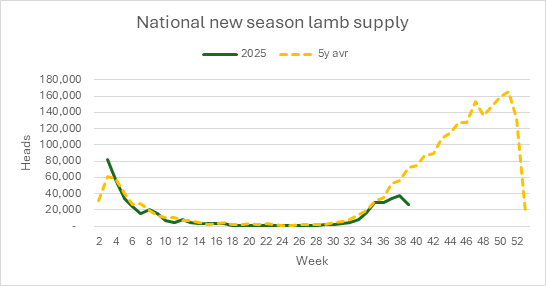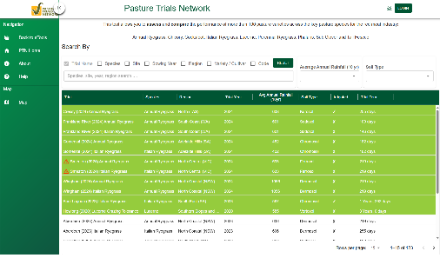New season lambs flush saleyard signals
Key points
- New season lamb prices have surged to an average 1,227¢/kg carcase weight (cwt).
- Competition is strong for anticipated new season lambs.
- Processors are competing for limited lambs, purchasing up to 70% of supply.
Australia’s new season lamb market has entered uncharted territory in the second half of 2025. The average prices for new season lambs reached 1,227¢/kg carcase weight (cwt) this week, with individual lots of heavy young lambs selling for up to $400/head in Bendigo during September.
National average new season lamb prices
Source: NLRS
The price surge reflects genuine scarcity. Old season lambs have mostly exited the system and the market is now anticipating the new season flush. However, seasonal conditions are delaying supply and tightening availability.
SA has been most challenged, with drought conditions forcing earlier turnoff and potentially constraining the spring flush. Victoria – which typically drives national supply in September – is also critical. September yardings in Victoria have been tracking 68% below the five-year average. On top of an expected supply reduction, improved conditions and positive forecasts for the next three months may encourage producers to add weight – further delaying the SA and Victorian flush.
NSW kicked off a strong August but supply eased quickly through September, signalling a smaller pool of available lambs for the spring run.

Source: NLRS
Processor demand driving competition
Record prices are also being driven by high processing capacity at a time of easing supply due to early liquidation. To meet contracts and keep plants operating, processors have been active in saleyards – in recent weeks accounting for up to 70% of new season lamb purchases.
This supply pressure has forced some processors to scale back operations, bringing forward maintenance shutdowns or reducing slaughter shifts to avoid chasing increasingly expensive stock. Selective buying strategies have also been implemented to manage input costs.
Shifting seasonal pattern
The new season lamb supply situation in the second half of 2025 may represent a significant shift from traditional seasonal trends. Supply is delayed as producers consider to either capitalise on record prices for lighter lambs or hold stock in hope of further gains.
For processors and downstream supply chains, the challenge is managing reduced throughput while maintaining product flow to domestic and export markets. With significant investment in processing capacity over recent years, underutilisation remains a risk if supply does not recover.
Attribute to: Emiliano Diaz, MLA Market Information Analyst
Information correct at time of publishing on 19 September 2025.




